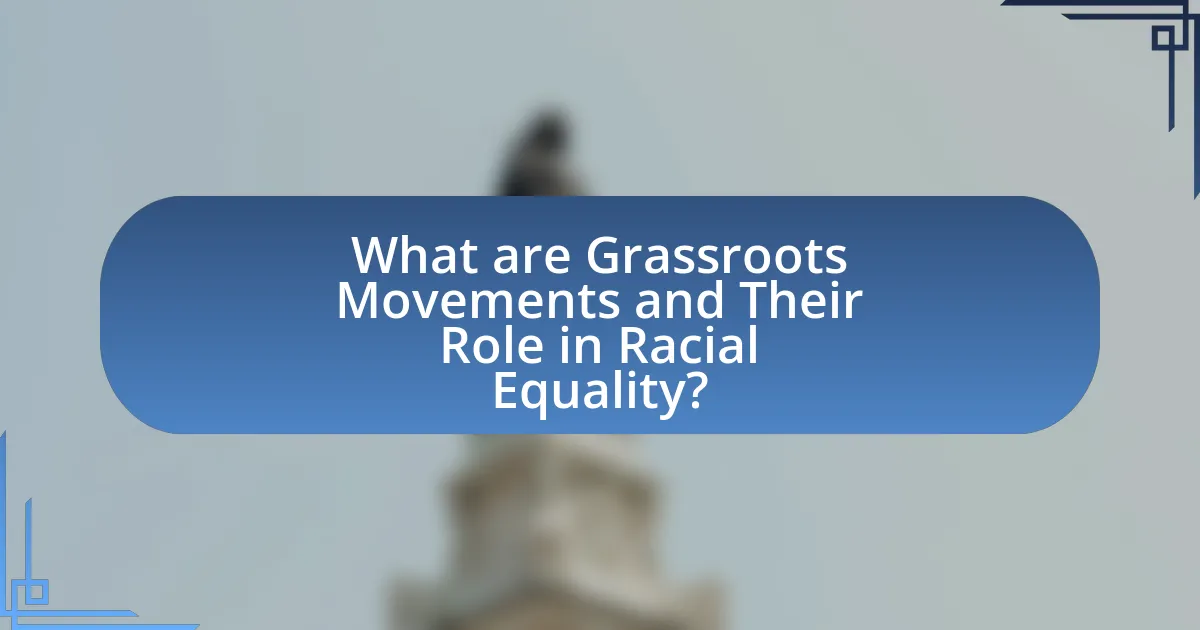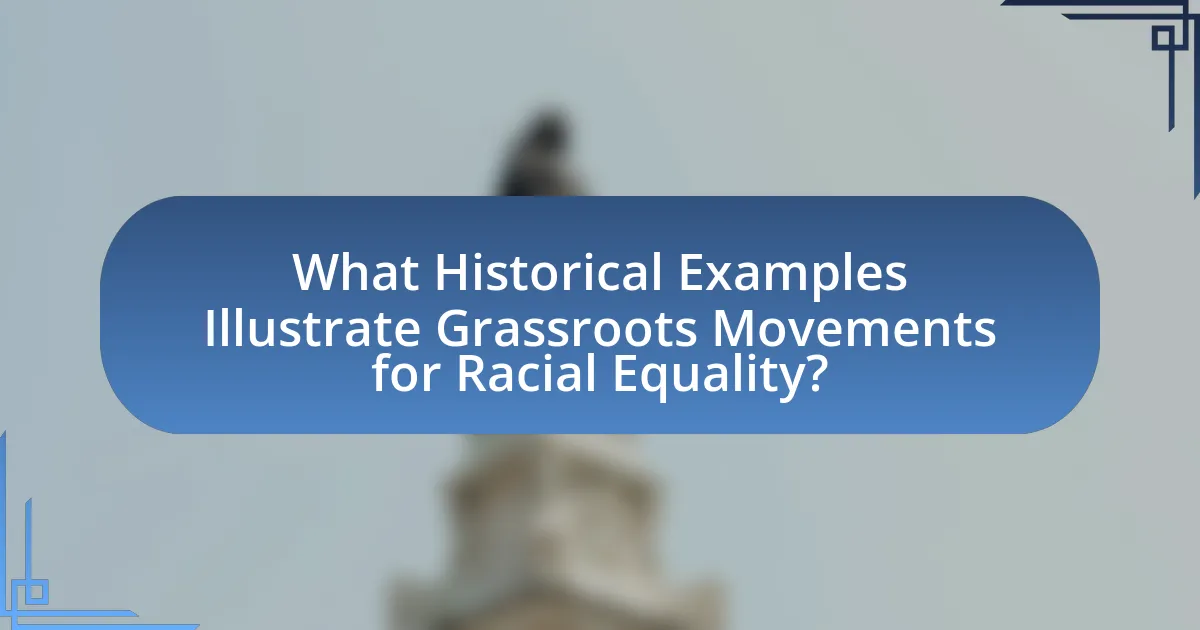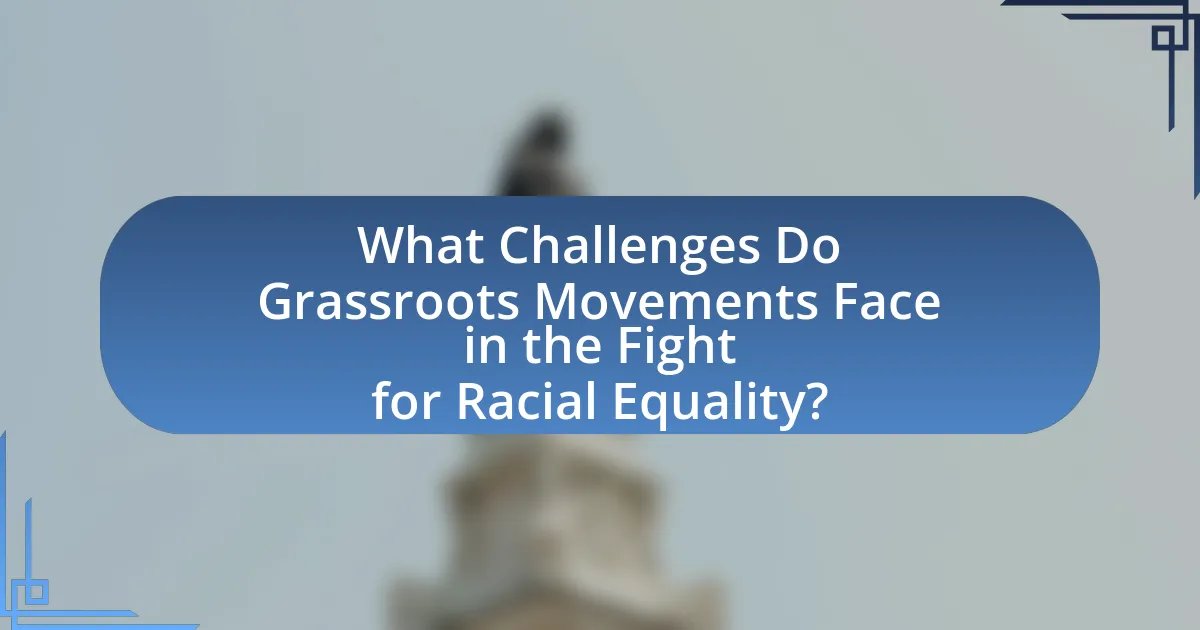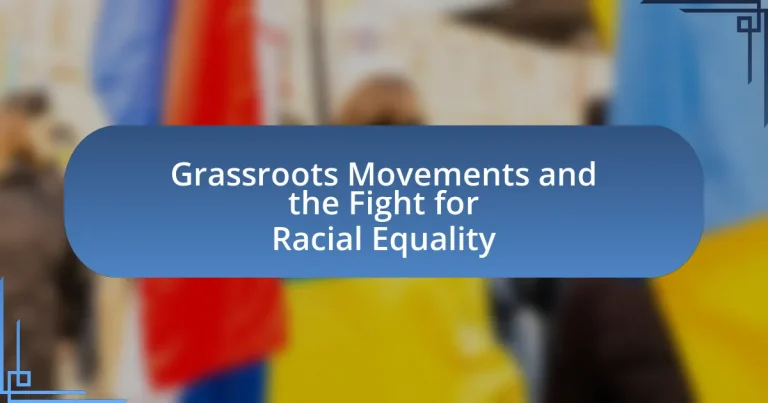Grassroots movements are community-driven initiatives that advocate for social change, particularly in the realm of racial equality. These movements mobilize individuals at the local level to raise awareness, organize protests, and influence policy, as exemplified by historical events like the Civil Rights Movement. The article explores how grassroots movements emerge in response to systemic injustices, the social conditions that foster their development, and the significant role of community leaders in mobilizing support. It also examines contemporary movements such as Black Lives Matter, the challenges they face, and the strategies they employ to engage communities and effect change. Through historical and modern examples, the article highlights the essential impact of grassroots activism in the ongoing fight for racial equality.

What are Grassroots Movements and Their Role in Racial Equality?
Grassroots movements are community-driven initiatives that mobilize individuals at the local level to advocate for social change, particularly in the context of racial equality. These movements play a crucial role in raising awareness, organizing protests, and influencing policy by directly engaging affected communities and amplifying their voices. For instance, the Civil Rights Movement in the United States during the 1960s, characterized by grassroots organizations like the Student Nonviolent Coordinating Committee (SNCC), successfully challenged systemic racism and led to significant legislative changes, such as the Civil Rights Act of 1964. This demonstrates that grassroots movements are essential in fostering collective action and driving societal transformation towards racial equality.
How do grassroots movements emerge in the context of racial equality?
Grassroots movements emerge in the context of racial equality through collective action by marginalized communities seeking to address systemic injustices. These movements often arise in response to specific incidents of racial discrimination or violence, such as the killing of George Floyd in 2020, which sparked widespread protests and mobilization across the United States. The emergence is facilitated by social media, which allows for rapid organization and dissemination of information, enabling individuals to connect and rally around shared goals. Historical examples, such as the Civil Rights Movement of the 1960s, demonstrate how grassroots efforts can lead to significant legislative changes, like the Civil Rights Act of 1964, showcasing the effectiveness of community-driven initiatives in advocating for racial equality.
What social conditions contribute to the formation of grassroots movements?
Social conditions that contribute to the formation of grassroots movements include widespread social injustice, economic inequality, and a lack of political representation. These conditions create a sense of urgency and collective identity among marginalized groups, prompting them to organize and advocate for change. For instance, the Civil Rights Movement in the United States emerged in response to systemic racism and discriminatory laws, mobilizing communities to demand equal rights and justice. Historical events, such as the Montgomery Bus Boycott, exemplify how social conditions can catalyze grassroots activism, leading to significant societal shifts.
How do community leaders influence the development of these movements?
Community leaders significantly influence the development of grassroots movements for racial equality by mobilizing local support and providing strategic direction. They often serve as trusted figures within their communities, facilitating communication and fostering a sense of collective identity among members. For instance, leaders like Martin Luther King Jr. utilized their platforms to articulate the goals of the Civil Rights Movement, effectively galvanizing public support and organizing protests. Research indicates that community leaders can enhance participation rates in movements by leveraging their social networks and local knowledge, which is crucial for addressing specific community needs and concerns. Their ability to connect with diverse groups and articulate shared values helps to unify efforts and sustain momentum in the fight for racial equality.
Why are grassroots movements essential for achieving racial equality?
Grassroots movements are essential for achieving racial equality because they mobilize communities to advocate for systemic change from the ground up. These movements empower individuals to voice their experiences and demands, fostering collective action that can influence policy and societal norms. Historical examples, such as the Civil Rights Movement in the 1960s, demonstrate how grassroots organizations like the Student Nonviolent Coordinating Committee effectively challenged segregation and discrimination, leading to landmark legislation like the Civil Rights Act of 1964. By engaging local communities, grassroots movements create a sense of ownership and urgency around racial justice, making them crucial for sustained progress toward equality.
What impact do grassroots movements have on public policy?
Grassroots movements significantly influence public policy by mobilizing community engagement and advocating for systemic change. These movements often raise awareness about social issues, leading to increased public support and pressure on policymakers. For instance, the Civil Rights Movement in the United States, which included grassroots organizations like the Student Nonviolent Coordinating Committee, successfully pushed for landmark legislation such as the Civil Rights Act of 1964 and the Voting Rights Act of 1965. This demonstrates how grassroots activism can directly shape legislative outcomes and promote racial equality.
How do grassroots movements mobilize community support for racial justice?
Grassroots movements mobilize community support for racial justice by fostering local engagement, building coalitions, and utilizing social media for outreach. These movements often begin with community members identifying shared grievances related to racial injustice, which creates a sense of urgency and collective identity. For example, the Black Lives Matter movement effectively organized protests and community discussions that highlighted systemic racism, leading to increased public awareness and support. Additionally, grassroots organizations often collaborate with local leaders and institutions to amplify their message, as seen in initiatives that partner with schools and churches to educate and mobilize residents. The use of social media platforms allows these movements to reach a broader audience quickly, facilitating the rapid dissemination of information and calls to action, which has been crucial in events like the protests following George Floyd’s death in 2020.

What Historical Examples Illustrate Grassroots Movements for Racial Equality?
Historical examples illustrating grassroots movements for racial equality include the Civil Rights Movement in the United States during the 1950s and 1960s, which was characterized by widespread activism led by individuals and local organizations advocating for desegregation and voting rights. Key events such as the Montgomery Bus Boycott in 1955, initiated by Rosa Parks, and the March on Washington in 1963, where Martin Luther King Jr. delivered his “I Have a Dream” speech, exemplify the collective efforts of ordinary citizens mobilizing for change. Additionally, the Black Lives Matter movement, which began in 2013, serves as a contemporary example of grassroots activism addressing systemic racism and police violence, demonstrating the ongoing struggle for racial equality. These movements have significantly influenced legislation and public awareness regarding racial injustices.
How did the Civil Rights Movement serve as a model for grassroots activism?
The Civil Rights Movement served as a model for grassroots activism by demonstrating the effectiveness of community organizing, nonviolent protest, and collective action in achieving social change. Activists like Martin Luther King Jr. and organizations such as the Student Nonviolent Coordinating Committee (SNCC) mobilized local communities to participate in sit-ins, marches, and voter registration drives, showcasing how grassroots efforts could challenge systemic racism. The movement’s success in passing landmark legislation, such as the Civil Rights Act of 1964 and the Voting Rights Act of 1965, provided a blueprint for future movements, illustrating that sustained grassroots efforts could lead to significant political and social reforms.
What key events defined the Civil Rights Movement’s grassroots efforts?
Key events that defined the Civil Rights Movement’s grassroots efforts include the Montgomery Bus Boycott, the sit-in movement, and the Freedom Rides. The Montgomery Bus Boycott, initiated in 1955 after Rosa Parks’ arrest, lasted over a year and successfully challenged racial segregation in public transportation, leading to a Supreme Court ruling that declared segregation unconstitutional. The sit-in movement began in 1960 when African American students staged nonviolent protests at segregated lunch counters, which garnered national attention and led to the desegregation of many establishments. The Freedom Rides in 1961 involved interracial groups traveling by bus into the segregated southern United States to challenge non-enforcement of Supreme Court decisions, resulting in violent confrontations and significant media coverage that highlighted the struggle for civil rights. These events collectively mobilized grassroots activism and significantly advanced the cause of racial equality in America.
How did grassroots organizations like SNCC and SCLC contribute to the movement?
Grassroots organizations like the Student Nonviolent Coordinating Committee (SNCC) and the Southern Christian Leadership Conference (SCLC) significantly contributed to the civil rights movement by mobilizing local communities and organizing nonviolent protests. SNCC focused on grassroots activism, empowering young people to lead voter registration drives and sit-ins, which were pivotal in challenging segregation and disenfranchisement. For instance, the Freedom Rides initiated by SNCC in 1961 aimed to desegregate interstate bus travel, directly confronting Jim Crow laws. Meanwhile, SCLC, led by figures like Martin Luther King Jr., coordinated large-scale demonstrations, such as the Birmingham Campaign in 1963, which highlighted the brutality of segregation and garnered national attention. These organizations not only facilitated direct action but also fostered a sense of community and solidarity among African Americans, ultimately leading to significant legislative changes like the Civil Rights Act of 1964 and the Voting Rights Act of 1965.
What contemporary grassroots movements are currently fighting for racial equality?
Contemporary grassroots movements currently fighting for racial equality include Black Lives Matter, the Movement for Black Lives, and the Poor People’s Campaign. Black Lives Matter, founded in 2013, focuses on combating systemic racism and police violence against Black individuals, gaining global recognition and mobilizing millions through protests and advocacy. The Movement for Black Lives, a coalition of organizations, emphasizes policy changes to address racial injustice and economic inequality, advocating for reforms in policing, housing, and education. The Poor People’s Campaign, revitalized in 2018, addresses the intersection of poverty and racism, aiming to unite marginalized communities to demand systemic change. These movements have significantly influenced public discourse and policy regarding racial equality in the United States and beyond.
How does Black Lives Matter exemplify modern grassroots activism?
Black Lives Matter exemplifies modern grassroots activism by utilizing social media platforms to mobilize supporters and raise awareness about racial injustice. The movement, founded in 2013, effectively harnesses digital tools to organize protests, share information, and create a global dialogue around systemic racism. For instance, the hashtag #BlackLivesMatter has been used millions of times, facilitating widespread engagement and participation in demonstrations, such as those following the deaths of George Floyd and Breonna Taylor. This grassroots approach emphasizes community involvement and decentralized leadership, allowing individuals to contribute to the movement in various ways, thus demonstrating the power of collective action in advocating for racial equality.
What strategies do contemporary movements use to engage younger generations?
Contemporary movements engage younger generations through digital activism, community organizing, and educational initiatives. Digital activism utilizes social media platforms to spread awareness and mobilize support, as evidenced by the success of campaigns like #BlackLivesMatter, which gained traction among youth through viral content and online engagement. Community organizing fosters local involvement by creating spaces for dialogue and action, allowing young people to participate in grassroots efforts that resonate with their values. Educational initiatives, such as workshops and seminars, empower youth with knowledge about racial equality and social justice, encouraging informed activism. These strategies collectively enhance participation and foster a sense of agency among younger generations in the fight for racial equality.

What Challenges Do Grassroots Movements Face in the Fight for Racial Equality?
Grassroots movements face significant challenges in the fight for racial equality, including limited funding, lack of media coverage, and internal divisions. Limited funding restricts their ability to organize events, mobilize supporters, and sustain long-term campaigns, as many rely on small donations and volunteer efforts. Lack of media coverage often leads to a diminished public presence, making it difficult for these movements to gain traction and influence broader societal narratives. Internal divisions can arise from differing ideologies or strategies among members, which can weaken their collective impact and hinder effective action. These challenges are evident in various historical and contemporary movements, such as the Civil Rights Movement, where funding disparities and media bias affected outreach and public perception.
What obstacles hinder the effectiveness of grassroots movements?
Grassroots movements face several obstacles that hinder their effectiveness, including limited funding, lack of media coverage, and internal divisions. Limited funding restricts the ability of grassroots organizations to mobilize resources, conduct outreach, and sustain long-term campaigns. For instance, a study by the National Committee for Responsive Philanthropy found that grassroots organizations receive only a small fraction of philanthropic funding, which hampers their operational capacity. Lack of media coverage diminishes public awareness and support, as mainstream media often overlooks grassroots initiatives in favor of larger, more established organizations. Additionally, internal divisions, such as differing priorities and strategies among members, can lead to fragmentation and weaken collective action. These factors collectively undermine the potential impact of grassroots movements in advocating for racial equality.
How do systemic barriers impact grassroots organizing efforts?
Systemic barriers significantly hinder grassroots organizing efforts by creating obstacles that limit access to resources, participation, and representation. These barriers include institutional racism, economic inequality, and restrictive policies that disproportionately affect marginalized communities. For instance, studies show that communities of color often face challenges such as limited funding opportunities and lack of political representation, which can stifle their ability to mobilize effectively. Additionally, systemic barriers can lead to a lack of trust in institutions, making it difficult for grassroots organizations to engage community members and build coalitions. This dynamic ultimately undermines the effectiveness of grassroots movements aimed at achieving racial equality.
What role does funding play in the sustainability of grassroots movements?
Funding is crucial for the sustainability of grassroots movements as it provides the necessary resources for organizing, outreach, and operational activities. Without adequate financial support, grassroots organizations struggle to maintain momentum, engage communities, and implement effective strategies. For instance, the Black Lives Matter movement has relied on donations and grants to fund protests, educational initiatives, and community programs, demonstrating that financial backing directly influences the movement’s capacity to mobilize and effect change. Furthermore, research indicates that movements with stable funding sources are more likely to achieve long-term goals and maintain their presence in public discourse, highlighting the integral role of funding in sustaining grassroots efforts for racial equality.
How can grassroots movements overcome these challenges?
Grassroots movements can overcome challenges by building strong community networks and leveraging digital platforms for organization and outreach. These networks foster collaboration, enabling members to share resources, knowledge, and strategies effectively. For instance, the Black Lives Matter movement utilized social media to mobilize protests and raise awareness, demonstrating the power of digital tools in amplifying grassroots efforts. Additionally, grassroots movements can engage in coalition-building with other organizations to strengthen their impact and broaden their reach, as seen in various civil rights campaigns that united diverse groups to advocate for racial equality.
What strategies have proven successful in building resilience within movements?
Successful strategies for building resilience within movements include fostering strong community ties, utilizing effective communication, and ensuring adaptive leadership. Strong community ties create a sense of belonging and support, which is essential for sustaining motivation and commitment during challenges. Effective communication, both internally and externally, helps to maintain clarity of purpose and mobilize resources, as seen in movements like Black Lives Matter, where social media played a crucial role in spreading awareness and rallying support. Adaptive leadership allows movements to respond to changing circumstances and challenges, ensuring that strategies remain relevant and effective, as demonstrated by the Civil Rights Movement’s ability to pivot tactics in response to opposition. These strategies collectively enhance the capacity of movements to endure and thrive in the face of adversity.
How can grassroots movements foster alliances with other organizations?
Grassroots movements can foster alliances with other organizations by actively engaging in collaborative initiatives that align with shared goals. These movements often identify common objectives, such as promoting racial equality, and reach out to organizations that have complementary missions. For instance, the Civil Rights Movement in the 1960s successfully allied with labor unions and religious groups to amplify their message and resources, demonstrating the effectiveness of such partnerships. By leveraging each other’s networks, resources, and expertise, grassroots movements can enhance their impact and create a unified front against systemic injustices.
What practical steps can individuals take to support grassroots movements for racial equality?
Individuals can support grassroots movements for racial equality by actively participating in local initiatives, donating to organizations that promote racial justice, and educating themselves and others about systemic racism. Engaging in community events, such as protests or workshops, fosters solidarity and amplifies marginalized voices. Financial contributions to groups like the NAACP or local advocacy organizations directly fund their efforts. Furthermore, self-education through books, documentaries, and discussions enhances understanding of racial issues, enabling individuals to advocate more effectively. Research indicates that informed communities are more likely to mobilize for change, as seen in the increased participation in movements following educational campaigns.
How can community members get involved in local grassroots initiatives?
Community members can get involved in local grassroots initiatives by participating in organized events, volunteering their time, and contributing resources to support the cause. Engaging in community meetings, joining local advocacy groups, and attending rallies or workshops are effective ways to connect with like-minded individuals and amplify efforts for racial equality. According to a report by the National Community Reinvestment Coalition, grassroots movements have historically driven significant social change, demonstrating that collective action can lead to impactful reforms.
What resources are available for individuals looking to educate themselves on racial equality issues?
Individuals looking to educate themselves on racial equality issues can access a variety of resources, including books, online courses, documentaries, and organizations dedicated to social justice. Notable books such as “How to Be an Antiracist” by Ibram X. Kendi and “The New Jim Crow” by Michelle Alexander provide foundational knowledge on systemic racism and its impacts. Online platforms like Coursera and edX offer courses on racial justice, often created by reputable universities. Documentaries such as “13th” by Ava DuVernay and “I Am Not Your Negro” provide visual insights into racial issues in America. Additionally, organizations like the NAACP and Race Forward provide educational materials and community engagement opportunities, reinforcing the importance of informed activism in the fight for racial equality.


